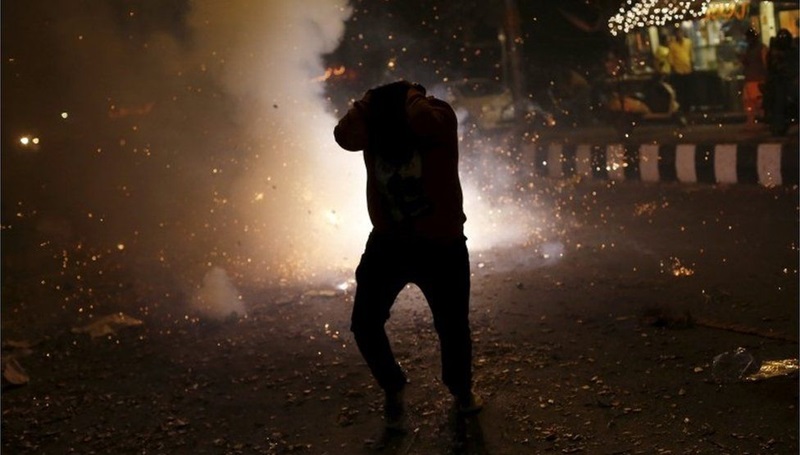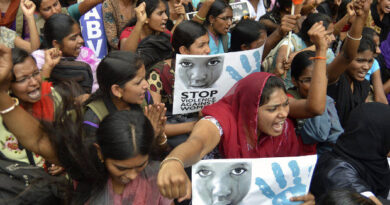Post-Diwali Blues: Delhi’s Air Quality Takes a Hit, Anand Vihar AQI Dips into ‘Very Poor’ Territory
New Delhi: A dense, harmful haze or ‘smog’ reappeared in Delhi, Noida, Gurugram, and neighboring areas on Monday morning, post-Diwali fireworks, violating the Supreme Court’s ban and exacerbating the pollution crisis in the National Capital Region. Despite the Supreme Court’s restriction on barium and banned chemicals in firecrackers, the aftermath of Diwali saw a visible decline in air quality, with thick haze severely limiting visibility.

Prior to Diwali, the Supreme Court had clarified that its ban on certain firecracker components extended beyond the National Capital Region (NCR) to the entire country. On Diwali day, Delhi experienced the best air quality in eight years, with an AQI of 202 at 7 am, marked by clear skies and sunshine. However, post-Diwali, the air quality deteriorated significantly.
As per the Central Pollution Control Board (CPCB), Anand Vihar recorded a very poor AQI of 312 at 8 am, with PM2.5 levels reaching 488. Similarly, RK Puram’s AQI was 305, dominated by PM2.5 at 455. The concentration of PM2.5 exceeded the World Health Organization’s limit by 20 times. The city government responded by closing primary classes and restricting truck entry.
By 5:30 am, Delhi’s air quality levels reached 514, categorized as “hazardous” by Swiss group IQAir, designating Delhi as the most polluted city globally on Monday. Anand Vihar recorded an AQI of 969 at 5 am, representing “hazardous” air quality. In Noida, the AQI stood at 269 (poor) in sector-62, with PM2.5 touching 500. Gurugram’s AQI was 329 (very poor), and PM2.5 levels nearly reached 500.
Despite the AAP government’s complete ban on firecrackers in Delhi, people were observed bursting crackers, contributing to the worsening pollution levels. The AQI, peaking in the ‘severe’ category, is anticipated to persist, posing breathing difficulties for residents. The government had considered ‘artificial rain’ to combat the foul air, but the sudden rainfall brought temporary relief. The 24-hour average AQI on Saturday was 220, the lowest in eight years for the day before Diwali. Last year’s Diwali recorded an AQI of 312, emphasizing the persistent challenge of curbing post-festive pollution.






This website certainly has all of the info I wanted concerning this subject and didn’t know who to ask.
Good info. Lucky me I reach on your website by accident, I bookmarked it.
Разыскиваете надежную помощь в наведении порядка квартиры в Санкт-Петербурге? Наша группа профессионалов дает гарантию чистоту и и порядок в вашем доме! Мы применяем только безопасные и эффективные средства, чтобы вы могли наслаждаться свежестью без хлопот. Заходите https://klining-uslugi24.ru – Уборка после смерти цена Не упустите шанс сделать свою жизнь проще и удобнее.
Устали от пыли и беспорядка? Клининговая компания в Санкт-Петербурге предлагает квалифицированные услуги по наведению порядка для вашего дома и офиса. Мы используем только экологически безопасные средства и гарантируем непревзойденный порядок! Тапайте https://klining-uslugi24.ru – Клининг СПб уборка квартир цена По какой причине стоит выбрать нас? Быстрая и качественная работа, индивидуальный подход к каждому клиенту и конкурентные цены. Доверьте уборку профессионалам и получайте удовольствие от свежести без лишних хлопот!
Устали от скучных уборок и вездесущей пыли? Клининговая компания в Санкт-Петербурге предлагает качественные услуги по уборке жилых так и коммерческих помещений. Мы заботимся о вашем времени, используя только безопасные и действенные средства. Наша команда профессионалов наполнит вашему дому или офису сиянием и организованностью, а вам — безмятежность и гармонию. Тапайте Уборка квартир СПб Вверьте наведение порядка нам и радуйтесь мгновениям, проведенным с родными и друзьями! Запишитесь на безвозмездную консультацию прямо сейчас и получите специальные предложения для вновь прибывших клиентов. Чистота — это не только работа, это наше призвание!
Ищете надежную помощь в наведении порядка вашей в Санкт-Петербурге? Наша группа специалистов дает гарантию чистоту и порядок в вашем доме! Мы используем только безопасные для здоровья и эффективные средства, чтобы вы могли наслаждаться свежестью без хлопот. Нажимайте https://profuslugi24.ru/ Не упустите шанс сделать свою жизнь легче и удобнее.
Разыскиваете проверенную помощь в наведении порядка квартиры в Санкт-Петербурге? Наша команда профессионалов гарантирует чистоту и и порядок в вашем доме! Мы используем только безопасные и действенные средства, чтобы вы могли наслаждаться свежестью без хлопот. Заходите https://chisto-v-srok.ru/
Мягкая мебель утратила былй лоск? Воскрешение мягкой мебели на дому в городе на Неве! Вернем диванам, креслам и пушистым коврам их истинную красоту. Экспертные средства и знающие свое дело мастера. Бонусы новобранцам! Детали ждут вас! Заходите Химчистка на дому
Мобильная чистка в СПб и ЛО! Диваны, ковры, удобные сиденья – возродим красоту и аромат свежести прямо у вас в квартире! Набирайте номер! Кликайте https://himchistka-spb24.ru – Сколько стоит химчистка дивана
В поисках надежного поставщика редкоземельных металлов и сплавов? Обратите внимание на компанию Редметсплав.рф. Мы предлагаем внушительный выбор продукции, обеспечивая превосходное качество каждого изделия.
Редметсплав.рф обеспечивает все стадии сделки, предоставляя полный пакет необходимых документов для оформления товаров. Неважно, какие объемы вам необходимы – от мелких партий до крупнооптовых заказов, мы готовы поставить любой запрос с прекрасным качеством обслуживания.
Наша команда службы поддержки всегда на связи, чтобы помочь вам в определении подходящих продуктов и ответить на любые вопросы, связанные с применением и характеристиками металлов. Выбирая нас, вы выбираете достоверность в каждой детали сотрудничества.
Заходите на наш сайт Редметсплав.рф и убедитесь, что наше качество и сервис – наилучшее решение для вашего бизнеса.
поставляемая продукция:
Рнструментальная круглая РїРѕРєРѕРІРєР° 185 РјРј 5РҐРќРњ ГОСТ 5950-2000 РЁРёСЂРѕРєРёР№ выбор круглых РїРѕРєРѕРІРѕРє для профессиональной обработки металла. Рнструментальная круглая РїРѕРєРѕРІРєР° высочайшего качества СЃ разнообразием размеров Рё форм. Повышенная прочность, износостойкость Рё превосходное качество изготовления. Обеспечивает отличное сцепление СЃ материалом Рё эффективную работу оборудования. Покупайте РїСЂСЏРјРѕ сейчас!
Очень приятные цены для такого качества! Буду советовать вас друзьям.
купить цветы томск
— Из рогатки, из рогатки, — подтвердила Маргарита, — а ты спи! — Это Ситник, — сказал мальчик, — у него есть рогатка. москитная сетка на пластиковые окна самому Недоросли и совсем малолетки давно разошлись.
Thank you a lot for sharing this with all people you actually know what you are speaking approximately! Bookmarked. Kindly additionally seek advice from my web site =). We may have a link exchange agreement among us!